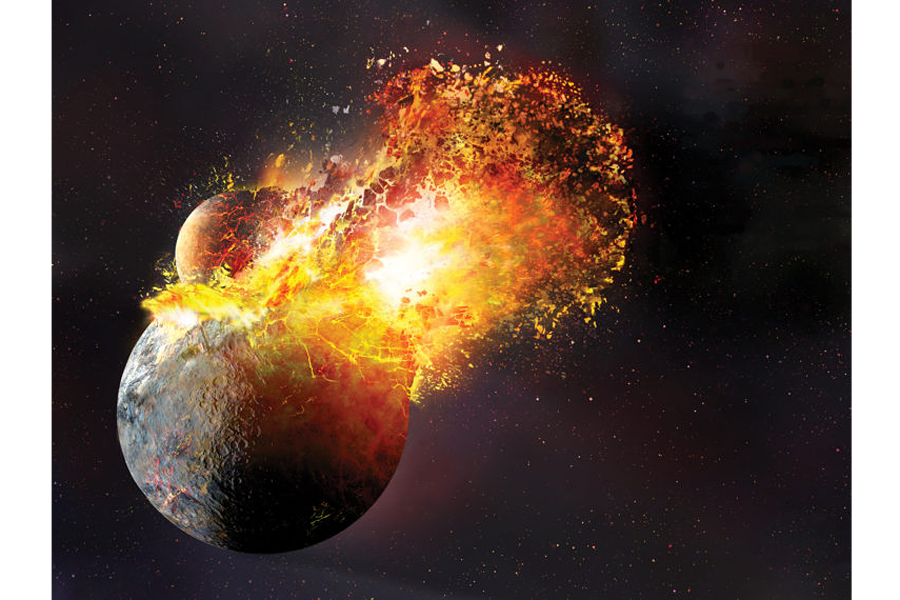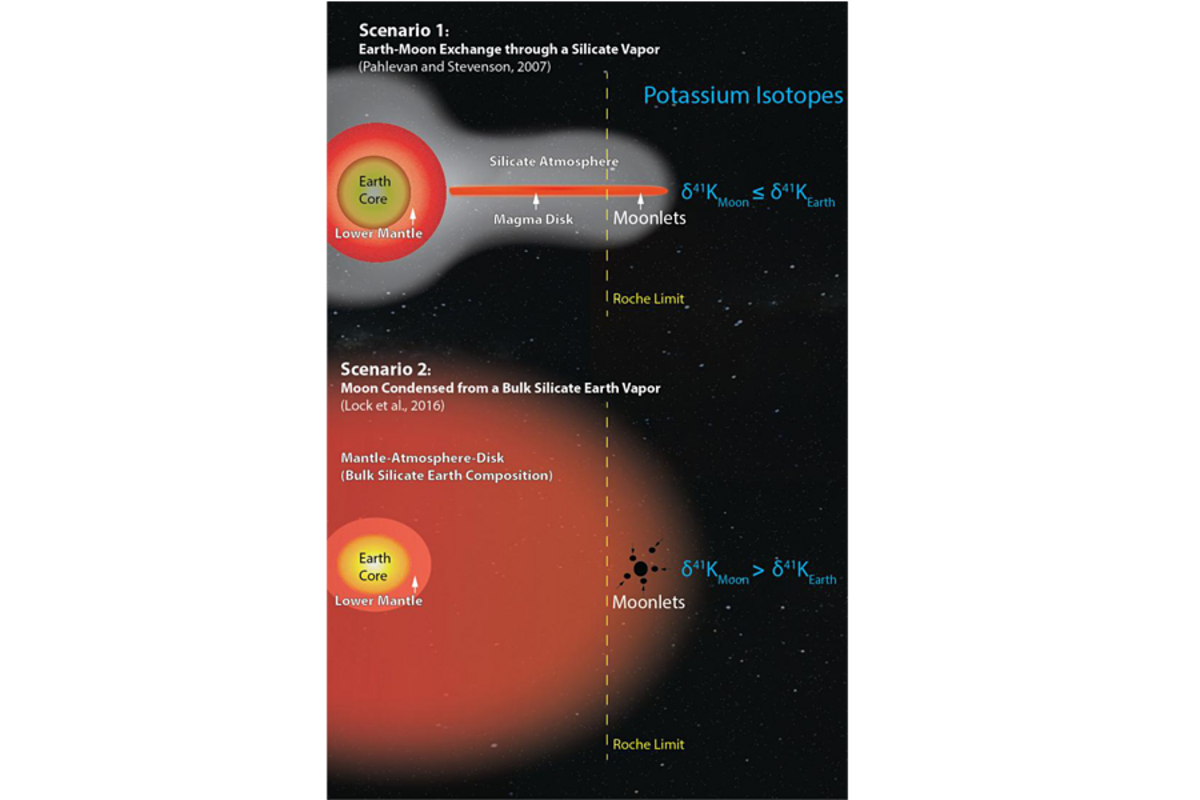Was the birth of our moon more violent than we thought?
Loading...
The birth of our moon might have been more violent than previously thought.
Scientists studied the chemistry of moon rocks and Earth rocks, and, in a new paper published Monday in the journal Nature, they say they now have hard evidence that a humongous, high-energy collision between the Earth and another large space rock could be the origin story for our lunar companion.
And pinning down this story could change our understandings of planetary systems across the universe.
"So much of what we understand about planet formation in general is premised on our ideas about how the Earth and moon formed," Robin Canup, an astrophysicist at the Southwest Research Institute in Boulder, Colo., whose research has focused on the formation of planets and satellites but who was not part of this study, tells The Christian Science Monitor in a phone interview. Because the Earth-moon system is the most easily accessible data, "It's sort of a linchpin for some of our ideas about how terrestrial-like planets form."
Speculation about the origin of our lunar companion has long been the focus of scientific inquiry.
René Descartes proposed one of the earliest explanations for how satellites come to orbit a planet in his "Le Monde," published in 1664, after his death. He suggested that smaller planetary bodies were captured by the pull of larger ones in a rudimentary version of the planet-capture theory, which was fleshed out by the American astronomer Thomas Jefferson Jackson See in the early 1900s.
Two centuries after Descartes, the French astronomer Édouard Roche proposed that the moon and the Earth had coalesced simultaneously.
Meanwhile, the English astronomer George Howard Darwin, son of Charles Darwin, proposed that the moon was actually a chunk of the Earth that had spun off early in our planet's evolution. Geologist Osmond Fisher just a few years later added the idea that the Pacific Ocean basin was the scar of that separation.
As scientists have learned more about the moon in more modern times, these three early models have seemed increasingly unlikely to explain the formation of our moon. Instead, a more spectacular, violent story began to emerge.
An epic collision
In what is the most popular scenario today, a Mars-sized space rock slammed into Earth about 4.5 billion years ago. The impact spewed debris from both planetary bodies into space, which formed a disk orbiting early Earth and eventually coalesced into what is now the moon.
The data gathered over the past few decades have largely fit this model. "Physically there's no problem. Mathematically there's no problem" with the model, the study's lead author, Kun Wang, an isotope geochemist and cosmochemist at Washington University in St. Louis, tells the Monitor in a phone interview. "But chemically, this model has a lot of problems."
Based on the original giant-impact hypothesis, as the model is called, the chemical composition of the moon should be distinct from that of the Earth, because the odds that the body that struck the Earth would be chemically identical to the Earth itself are vanishingly small. But that's not the case with the Earth and the moon: chemically, they are practically identical.
"Clearly some kind of giant impact is involved for the origin of the moon," Ross Taylor, a retired astrophysicist whose research focused extensively on the formation of the moon, who was not part of this study, writes in an email to the Monitor. But "The similarity in composition to the Earth for the other elements is a more recent discovery, causing a crisis for conventional giant-impact models."
So scientists began tinkering with the model to figure out how the material that formed the Earth and the moon might have mixed more than was previously thought, and a few scenarios emerged.
One of the dominant new models suggested that a thin silicate atmosphere formed in a low-energy impact scenario, and through that atmosphere material was exchanged.
But Dr. Wang's new measurements don't match that scenario either.
Wang and his colleague Stein Jacobsen analyzed seven lunar rocks and eight terrestrial rocks to compare the ratio of potassium isotopes, in a hunt for clues as to what really happened.
"Potassium has two major stable isotopes, one is 41, one is 39," Wang explains. Potassium-41 is heavier than potassium-39. In the moon rocks, Wang found that the isotopic ratio made it so that the potassium was heavier than on Earth. And this rules out the silicate atmosphere model, which would have the lunar rocks as more rich in potassium-39, he says.
Instead, the potassium isotopes support a brand new model, Wang says. This theoretical model is so new that it has only been described in conferences and has yet to be published in a scientific paper. It goes something like this:
A giant planetary body slammed into the early Earth with so much force that it vaporized much of the Earth's mantle as well as the impactor. The whole system was swirling with vaporized debris.
As that vapor began to cool following the high-energy collision, the melt that condensed out of it was made up of the heavier isotopes, such as potassium-41. That material eventually accreted into the moon and back onto Earth. Meanwhile, the lighter isotopes were still in the vapor. Although all of the isotopes were pulled back to Earth by its gravity, because the forming moon was at the edge of the system, the potassium-39 filled vapor didn't accrete onto it as readily.
"So that's why we can see this isotopic difference between Earth and moon," Wang says.
Dr. Canup suggests that Wang and Dr. Jacobsen are getting ahead of themselves by ascribing their data to this model. "I think it may be true that the model can explain this data," she says, "but I don't think it's clear that the other models couldn't explain this data."
"At this point, the data is ahead of the models," Canup says. But "this is a key new piece of the puzzle. It's a key new constraint" for the models.
The new data certainly help rule out some models, Dr. Taylor agrees. And such a high-energy impact model "would explain the absence of a signature from the impactor, a problem with the canonical model."
This isn't the first chemical constraint on versions of the giant impact model, Thomas Kruijer, an astrophysicist at the University of Münster who was not part of the research, writes in an email to the Monitor. Titanium and tungsten isotope data have also ruled out the original and other versions of the giant-impact hypothesis, he explains.
"Nevertheless, deciphering the Moon’s origin is a very complicated puzzle, and solving it requires many pieces of evidence," he says. And the new research adds "an important new piece of evidence, and this sense, I believe the results are rightfully published in a journal like Nature."







